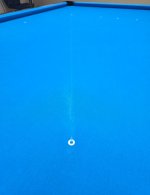So - the background is that I start off everyday with the Mighty X drill before moving on to shot & position drills. Over the course of several months, I've started to see cue chalk dispersion patterns (see attached pic) that indicate my follow-through is consistently off to the left (I'm a right-handed shooter). I have cams set up that I review footage of as well and it seems that my stroke until contact is straight, I think the non-straight follow-through occurs afterwards when the cue hits my chest and bounces off.
DrDave posted on the same issue here: https://forums.azbilliards.com/threads/crooked-pro-pool-strokes-in-video.506196/post-6565741
Here's my question - how important is it to maintain a straight follow-through after contact? I found that I can only achieve this by (1) changing my angle of addressing the cueball so my cue is no longer directly underneath me but more off to the side or (2) standing up taller and lowering my stroke / increasing distance between my chest and my cue. Both of these options result in decreased accuracy for me.
With my current stroke, I'm able to do an abbreviated Mighty-X (stop 10x, follow 10x, draw 1x into origin pocket) on a daily basis fairly quickly and run racks on occasion so I think my stroke is straight, or at least I don't feel that I'm consistently off to the left or right. Should I consider retraining my stroke completely? Or is it 'normal' for the follow-through to deviate after cue contact?
DrDave posted on the same issue here: https://forums.azbilliards.com/threads/crooked-pro-pool-strokes-in-video.506196/post-6565741
Here's my question - how important is it to maintain a straight follow-through after contact? I found that I can only achieve this by (1) changing my angle of addressing the cueball so my cue is no longer directly underneath me but more off to the side or (2) standing up taller and lowering my stroke / increasing distance between my chest and my cue. Both of these options result in decreased accuracy for me.
With my current stroke, I'm able to do an abbreviated Mighty-X (stop 10x, follow 10x, draw 1x into origin pocket) on a daily basis fairly quickly and run racks on occasion so I think my stroke is straight, or at least I don't feel that I'm consistently off to the left or right. Should I consider retraining my stroke completely? Or is it 'normal' for the follow-through to deviate after cue contact?
